Like any vital, living thing, the art world is ever evolving. In the distant past, paintings were accomplished in the studio by painstaking application of layers of paint over a period of sometimes years. In the not-so-distant past, the trend toward alla prima painting increased the expectation of completing a piece in a much shorter time span. In the present day, time-lapse videography has made it possible to witness a 3-hour painting demonstration in eight or ten minutes! Now, there’s a wicked thing in my head that tells me I’m incompetent if I can’t paint a decent demo in eight or ten minutes. Not literally but, well, almost literally. The truth is, I’m a slow painter. I want to be a fast painter and this has steadily stolen my focus away from the simple joy of painting. This year I learned that I’m not alone; there’s a bunch of us trying to get faster. It’s a painters’ version of anorexia: you see the magazine cover of the perfect quick-draw painting and look at yourself to see if you’re good enough. You’re not good enough in your eyes so you start starving yourself and exercising and self-destructing, when all along you really were good enough; you were just different! Maybe you need someone to tell you that. Maybe I do, too.
At the end of last year, I decided that I wasn’t fast enough to be good enough to call myself a plein air painter. I set my goals for this year, and my Number One Goal was to learn to be a really fast landscape painter. My training heretofore was exclusively studio and mostly portrait-oriented, and while I’d been painting outdoors for more than a decade (and frankly loving it with an unadulterated love), I’d never actually been taught how to paint en plein air. My plein air works were, in the words of Robert Genn, “unabashed two-steppers.” I would paint as much as I could on site and then finish the rest later, using my mixes, my start, and my reference photos. I hadn’t entered any plein air events because of that, and I have felt more and more ashamed about it. Well, that was all about to change because I signed up for two workshops at the beginning of this year; one with Ray Roberts and the other with Jill Carver.
Both of these great artists and great teachers asked their students what they hoped to gain from the respective workshops and the answers were pretty much the same: we all wanted to learn to think and paint faster in the field: to come to a place and be able to compose a finished painting in our head while we were setting up, mentally Photoshop trees and rocks and rivers in and out and all around a canvas, capture the essence of it before the light changed, be able then to slap a frame on it and win a gold medal. That’s what we all hoped to learn.
Here’s what we all did learn: sometimes what you think you need to learn is different from what you actually need to learn. The gentle admonition from them was, it’s not about speed: that’s asking the wrong question. Jill suggested that there would never be an entry in an art book saying, “Painted between 2:00 and 3:45 p.m., whilst competing against so-and-so.” No, the painting must forever speak for itself and if you can’t paint it well going super fast, slow down. Neither of these painters comes to a landscape with an expectation of coming away with some kind of slap-dash masterpiece. Roberts’ approach was to consider plein air work as fact-finding and idea-catching, making numerous small sketches with an eye toward a studio piece. And Carver’s strategy was to make it less of a hunting expedition (her words) in which you “bag a prize,” and more of a private conversation with a friend. Her approach was very slow and polite; sketching ideas in a book with a sharpie and making notes before her kit was ever unpacked for painting. When she does get her gear out, she often divides up the canvas into two or four sections upon which to paint her response to the landscape. I’ll tell you how this affected me: I felt liberated. Liberated from my own expectations and free to be myself out there.
When I watch great painters paint, they do not ever seem to be in a hurry. Even if they accomplish a painting in a short time-span, they are very deliberate in their application. I felt all warm and tingly when I learned that my hero, John Singer Sargent, might paint and scrape a head sixteen times, so as to ultimately leave a fresh mark that seemed quick and effortless. But even before that, he’d done dozens of sketches. Seeing the plein air studies of another hero, Joaquin Sorolla, was exciting because they were all so tiny and jotty, like the shorthand notes of a writer! When I shared with my husband my new goal to be a fast painter, he said, “You don’t do anything fast! Why would you want to do the thing you love the most fast?” None of these things will sink very far into a hard head.
When Jill Carver paints a place, she has first loved it. Her painting is a poem about it. She has already sketched different versions of it and maybe painted several studies before she approaches the Painting Proper. When she set up for one demo, she situated her canvas so that her back was toward the subject. By doing this, she could only paint whatever she remembered once she was facing the canvas. This is an old Robert Henri trick. It requires a bit of your soul. But it takes a little longer.
Here are some studies done by Jill, exploring the number of values needed to convey a scene, preferring to keep it between three and five. This is one of the ways she helps her students to deconstruct and tune into the scene. Note the way she matches the colors to the values:
While we were working outside, her repeated, disarmingly funny, admonition was, “Paint what you see and keep it simple: after all, this is not rocket surgery.” She encouraged her students to relax and let the scene choose us, let it reveal itself to us; that requires calm and quietude. It is much more courteous and respectful than the smash-and-grab technique that I thought I wanted to learn.
Ray Roberts was working with rapidly changing light because, as luck would have it, we had rare weather blowing through the desert while we were out there, including riotous thunder storms! It was exhilarating to watch him work; he engaged the constantly changing light by constantly changing canvases! I know I would have decided to stay in the studio if the weather were unpredictable like that, but he taught us to move with the weather, to let it speak to us and take dictation so we could report our experience later. Our steno pad was the canvas, 8×10’s quartered, so that we could make four 4×5 inch paintings of the changing light. If he ran out of spaces, he tossed one canvas panel to the ground and picked up another, never chasing the light in one piece, but letting every change have its own space to speak. And again, he wasn’t slapping on the paint at 90 miles an hour; he was brief and deliberate, making exact notes that would bring a flood of memories back in the studio. His experience in the field was respectful and joyous, and that was conveyed in both the sketches and in the studio painting he did from them.
Here are some of the field studies done by Ray, and the studio painting that sprang from them:
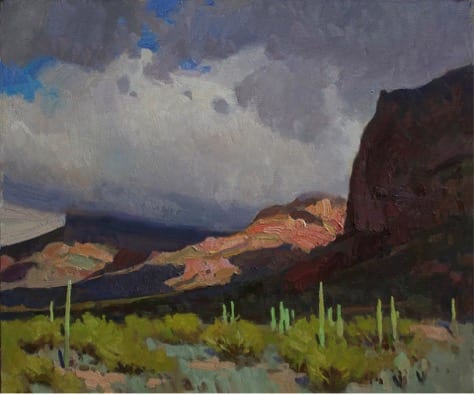
Notice how pieces of the studies found their way into the final painting, which truly captured the spirit of the experience, even though that single scene only existed in his mind’s eye.
Having been a runner, I know that there are some people who are good long-distance marathon runners, and others who are good short-distance sprinters; there are very few people who are good at both. There are master artists who enjoy the quiet, drawn-out pace of a marathon painting, working weeks or months (or years!) on a single piece, but who could not do a one-hour demo in front of an audience to save their own life. Then there are master artists who absolutely love the adrenaline-fueled fast pace of the quick-draw events and are astonishing in their ability to nail a sketch in one or two hours, but who could not spend any more time than that without going stir-crazy, and would never re-enter a painting that’s been “finished.” But! Sprinters do run long-distances when they are in training, and distance runners do train by running sprints for the same reason: it makes them better at what they’re good at.
So there are sprinter-painters who start out with a bang and run full-tilt to the tape, and there are marathon-painters, who have a relaxed stride and who pace themselves to endure a long run. But here’s the thing: painting is not a performance art. Jill’s right: the thing that will outlast us is the body of work we leave here. Focusing on speed, even if I secretly still want to paint fast, is focusing on the wrong thing. Use speed-painting as an exercise, not as a standard of excellence. Paint a lot! Remember, a million miles of canvas is one of the things it takes to make a great painter. And the more a person paints, the better a person learns to say more with less. It will happen at some point that it will take less time to do that well.
Ray Roberts and Jill Carver are able to produce masterpieces in the studio that are gleaned from their work in the field. They are also able to produce truly inspired pieces in the field because they are out there working in all weather, day in and day out: they are good because they train and hone their gift.
So now that the Year of Painting Fast is half over, I’m reassessing. Sometimes a person has to readjust their goals in order to be true to their purpose. My real purpose is to be the best artist I can be, and maybe I, personally, can’t do that by painting fast. We who call ourselves artists have chosen to run a road that is not easy, but we love it and that’s why we’re here. Applaud the sprinters, cheer the marathon runners, and enjoy your own journey. Press in happily and hard to the thing that makes your heart skip and sing when you paint. There are a lot of things going on out there but we really don’t have to do them all; we’re not failures if we don’t do them all. We need to just do our best thing in the very best way we can. Getting to do what you love is such a rare thing. We shouldn’t ruin it by wishing we could do something else. I think the thing I was starting to lose in my quest for quickness was the experience of just enjoying spending that time doing what I Iove to do! That old adage, “haste makes waste,” is an old adage for a good reason: it’s true! Haste could waste the thing that made you start on this road to begin with: the joy of painting.
So I’m adjusting my sights for the second half of this year: the point is the product, not the pace; this is not a race! I’m going to write a card to stick to my Soltek: “Haste Makes Waste~ Embrace Your Pace.” Even if I still feel the need for speed!
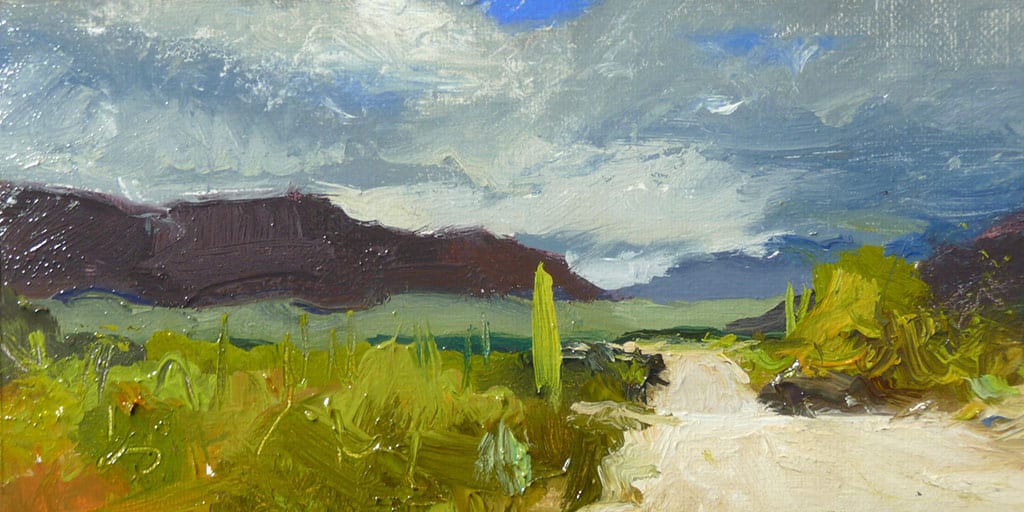
7×11
“Painted Between 2 & 3:45 Whilst Competing Against Kim Carlton”
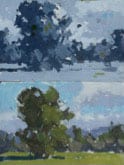
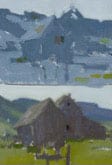

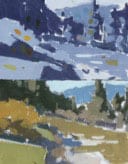




Suzie Greer Baker says
Kim! I love what you had to say – so poignant! You are giving us permission to find our own speed and saying “out loud” what we all need to hear. I plein air paint in events and I offend remind myself that the format can be the hobgoblin of a good painting due to the nature of the process. I try to overcome this with sketches and knowing my subject prior to putting oil to canvas. Still some paintings come home with me un-displayed because they just didn’t cut the muster. Love your work Kim. Love your writing!
Kim Carlton says
Thank you, Suzie! I found out that I’m not alone and felt so grateful and free, not only for the permission to slow down, but for the company of so many really good painters who feel the same way. I hadn’t planned to write about it, but suddenly felt that I HAD to write about it, so other people could hear what Jill and Ray say.
It’s good to hear from a natural-born sprinter like yourself!
john pototschnik says
Wonderful article, Kim Carlton. Loved it. Loved it. Expressed well, but also true.
Kim Carlton says
Thank you, John~ that means a lot coming from you.
Marsha Savage says
This came at such a good time for me. I have been trying to figure out who Marsha Savage really is in her art. I have almost lost it. And, I have another friend that posted on Facebook about seeing all the wonderful artwork by her friends and wondering what is wrong with hers. So, I read two of your paragraphs and then copied and pasted the link to her post before I even finished reading this. It is even more wonderful the further down one reads. You hit the nail squarely on the head! Thank you so much. I knew I decided to not do the plein air events after doing a few (the national and regional type) because I felt intimidated. My purpose and what I tell my students, because I do teach plein air workshops, is I never go out there thinking I am producing a painting. It is my classroom and I love nature, so I want to just enjoy the process and being there. Gathering those notes and learning how to recreate it in the studio … love it! Thanks again… absolutely wonderful and needed post!
Kim Carlton says
Thank you, Marsha. Thanks for the response but even more, thanks for being a teacher who empowers her students! They are lucky to have you.
David Anderson says
Kim, Years ago I attended the American Academy of art where it seemed like a former
student Richard Schmid inspired us to paint like him with an alla prima approach. I believe he is one of this generations great artists. I have always felt like a failure if
I couldn’t bring home a finished painting from my plein air painting outings. It was
like I either wasn’t good enough, or fast enough to pull it off. After reading your article
I’m inspired to try and cut the tie I’ve had and just be myself and try and capture my view of our world.
Thank you!!!
Kim Carlton says
What a great beginning!!! It’s exciting to think that someone with your background is about to expand and explore the boundaries of his world; there’s only one person in the universe who has what you have~ thank you in advance for sharing it with us, David.
Emma Hutch Art says
Great article Kim thank you, I’m doing more work with pencil & charcoal as I paint too slow & get annoyed as I feel I should be quicker & like you I am afraid to tackle plein air, it’s so reassuring to hear if other artists in the same boat don’t
Kim Carlton says
Thank you, Emma. I know a couple of people who do all their initial work in the field with pencil and they make notes using color charts. That way, they are totally focused on the moment, no pressure. Most of our pressure is self-imposed, I think 🙂
joyce snyder says
Thank you Kim for such a thoughtful and caring post. As a lover of nature and painter I struggle to find “results”. Your article has inspired me to just enjoy the process…and wait for the results. Don’t stop writing..it is second to none.
Kim Carlton says
Wow, Joyce. Thank YOU for such a thoughtful and caring post!
Mary Rose says
Thank you for your article. I believe that we, many of us, are prone to copy others and when we think we must do as someone says, as in, painting fast, shows that other people have a lot of influence even though they may be lousy painters. Trends are newsy; they sell things, and “painting fast” has nothing to do with good art, although some artists are naturally fast. But why should we care about what the latest decree is? Why do we need permission?
Rosemary Holusha
Kim Carlton says
Thank you, Rosemary~ that’s what Jill taught me when she said, No one’s going to know (or care!), in 50 years, how long it took to accomplish a painting! She’s been advocating a slow-down for a long time, even though she’s a fast painter. I’m really grateful for the permission…
Mary Rose says
Thank you Kim for your response. My response was meant to convey that we don’t need permission; where did this term come from? Does anyone believe that Monet, Cezanne, et al, needed “permission”. We rely too much on someone else’s terms, who in the world started this whole “permission” thing? We need to stop using the term.
Kim Carlton says
Oh, I think I understand what you are saying now. It probably comes from the student-teacher relationship in which a teacher shows a student what to do and a student asks permission to do something different. Once a student graduates, he doesn’t have to ask permission anymore, but still may be confined by the teacher’s instruction. You are right, Rosemary; we really don’t need someone’s permission. Thank you.
Sandy Askey-Adams says
Thank you Kim!!! Many thanks. You have done a good deed in writing this article, maybe more so than you realize. I think I am that particular artist that Marsha Hamby Savage mentioned in her comment….(she has so many friends.) After I wrote and posted how bad I was feeling about my art, good grief, never had I expected to have the support and encouragement from sooooo many artists. We are all falling at times and trying to pull ourselves back up and at times we need the hands of other understanding artists to reach out and help pull us back up on our feet. We can feel so alone at times until other artists pull our heartstrings and remind us we are not. That is the beauty of the soul of artists. What a special calling in life — being an artist among other artists.
Kim Carlton says
I agree, Sandy. I’m very grateful to the OPA for providing a forum like this. I think the “falling” that you mention might be fatal (artistically speaking) if there were no one there to pick us up again. How can they know to help if they don’t know we’ve fallen? I’m glad for the honesty and generosity of people who admit their struggles and lend a hand or heart. Yeah, your last thought: such a blessing.
Patty Curtis says
Thank you Kim, great to see this! Good to read the thinking behind the process of plein air painting challenges in real time. Training the mind & eye, hand/heart into a time span is one that takes time and patience to learn. Then to relax with that skill, wonderful freedom !! Truly a pleasant gentle journey to be shared with fellow painters~
Love your articles & paintings of inspiration, Thanks 🙂
Kim Carlton says
Thank you, Patty! I am really looking forward to our workshop this fall, speaking of pleasant journeys 🙂
Kim Carlton says
I have received so many private emails in response; I wish I could re-post them here, as they are very uplifting and encouraging! For the sake of this thread and the responders in it, I will say that it is so gratifying to be in a community of people who sincerely care about each other and about excellence. I feel like we are carrying some kind of important torch, and to quench the flame ourselves, with self-doubt or worse, is like breaking a sacred law. You are fanning the flame though. A whole bunch of little candles brought together will shed a great light! And what are painters about, if not the light?
robertmmccall says
Great post. I find reflection a wonderful tool, and like to look back at my mistakes so I can take action the next time I`m out there in the wide blue yonder. So, I find 1.5 hours of intense concentration, or perhaps I should say, relaxed meditation, really helpful, even if I think the finished work is a disaster, I later see it in a different light (pardon the pun) and learn to retool for my next voyage. It`s a journey and there is no loss in my mind. Each time out is a win. The birds sing, butterflies dart, the wind and sun still shine – it`s the space, without time I find encapsulating.
Kim Carlton says
Literally! When I see it in a different light, I want the freedom to “fix” things without feeling like a cheater. That’s why I’ve been shy about claiming to be “A Plein Air Painter.”
Thank you, Robert, for sharing the idea of singing birds and darting butterflies: the reason we’re out there!
Rusty Jones says
Great piece Kim. It’s good to see accomplished painters like yourself still searching and reaching and attending workshops. I have the exact opposite problem because i paint plein air so much slowing down in the studio becomes a problem. I get bored really quick on large pieces and especially on those that take several days to complete. The only way to combat the problem is to work on several pieces at at time so when the boredom sets in I move to a different painting. I think the current trend in plein air events to paint large canvases so the work stands out at the sale is compounding the problem of the need to paint fast. Thank you for writing such a thoughtful and thought provoking piece.
Kim Carlton says
Thank you, Rusty. You are a wonderful sprinter! And you have good ideas for keeping it fresh and beating boredom in the studio~ thanks for sharing that.
In my one and only plein air event, I sabotaged myself by only bringing large canvases, for the very reason you stated: to stand out in the show. What a dope! I did stand out, but not because of the large format. That just made my super-bad painting even more noticeable, haha!
Martin Wessler says
Kim! I too love your blog about pacing. I consider myself a good plein air artist but I certainly don’t always paint fast and I don’t do well under pressure. I know some ‘purist’ plein air painters consider me a ‘failure’ because I don’t knock out perfect gems fast, but I also know I am connecting with my ‘art spirit’ in a very personal way that makes me who I am. I also heard Ray Roberts say on a DVD that he early on had a teacher that told him the same thing that liberated him; that painting our doors is a huge challenge and it is best to consider it an exercise to collect color notes and composition ideas for later studio paintings. Liberated me too!
Kim Carlton says
I love that, Martin! I am really proud of the fast painters who do “knock out perfect gems fast.” It’s just one of the ways of painting though~ that’s what I’m learning.
You’re right, it is liberating 🙂
Nancy says
I have taken a big sigh of relief; thank you
Kim! I feel I am a painter with skills and talent
but was getting lost in expectations – of my own doing. I was painting because I love it but for others agenda.
Nancy
Kim Carlton says
Thank you, Nancy~ I think it will be easier to paint well if we let other people keep their own agendas and we stick to ours! It’s a version of “bloom where you’re planted.” I got planted in the slow-bloom garden 🙂 If I keep up-rooting myself, I’ll never be as pretty as I was supposed to be!
Lyn Boyer says
Bravo Kim. Thank you for the very well written article. With the public face of plein air feeling like it was becoming more and more ‘performance art’ the joy of my plein outings had been slipping away. This is a wonderful affirmation of ‘hurrah for the hares AND the tortoises’. May we all never lose the joy of creating and in the process leave our own unique beauty behind in the world – however we get there.
Kim Carlton says
Oh Lyn, I love that! Thank you; I agree with you. I think I falsely identify with the hares, so looking in the mirror and seeing a tortoise is shocking at first. But the tortoise really “sees” the territory he’s trekking! That is its own kind of joy. I toast your “Hurrah:” May we all never lose the joy! >clink!<
Lyn Boyer says
Perhaps we’ll cross paths and can raise that glass together someday Kim! >clink!< Yes! We truly get to "see" and "feel" as we trek along instead of buying a ticket on the bullet train. "Paint slow and prosper!" – ancient tortoise blessing. 🙂
Kim Carlton says
Hahaha! It’s a date!
Anna Rose Bain says
I second Suzie’s comment – I read every word of this post and found it so inspiring and encouraging!! Thank you for sharing this with the rest of us. It is worth reading over and over as a reminder that art is not a race, but a beautiful journey. Thank you!!
Kim Carlton says
Thank you, Anna~ you seem to do a remarkable job staying apace in the landscape of your beautiful life!
Judy Crowe says
Kim, Thanks friend for sharing your heart and great mind. You made us all feel better about being in our own skin, finding our own unique voice, loving who God made us-where we are, blooming where we are planted. Inspiring! Thank you.
Kim Carlton says
Judy, thank you so much for getting the heart of it! It’s not about painting fast; it’s about being happy while painting, fast or slow! You are very, very good at capturing the essence of the beauty very quickly, in a way that I truly admire.
Kathryn Townsend says
Kim–your “speed” painting is lovely–brushwork amazing–I love it. I agree that speed just for the sake of speed doesn’t really make sense. But speed has its merits out in the open, because of the light changing, if for no other reason. I find that when I start I’m in my “right brain”, with a big brush and a lot of paint, with no time to think and re-think into some idea of “perfection.” At a certain point, at about the 45 min to 1 hour mark, there is a shift and the left brain enters into the picture and though the “feeling” of the painting can be completely ruined by this, its not necessarily a bad thing–just means I have to physically step back and see the painting with my whole brain. if that makes any sense. I have to modify the pace because the incline has changed, so to speak. This is an analogy I’ve never considered before and will have to give it some thought. Pace is amazingly important, as you say. I was just thinking about that yesterday hiking on Mt. Rainier–learned about finding my pace when I hiked the 100 mile Wonderland Trail when I was 16. Have never forgotten that lesson. And now it is occurring to me for the first time that there are different “inclines” on the trail of painting, and the pace shifts accordingly–no need to rest going up a steep incline if the pace is the right one, but also important to stop every now and then and look at the view!
Kim Carlton says
Kathryn, thank you for mentioning the painting; it was one of four that I did of that scene, allowing 20, 30, 45 and 90 minutes as I went, to see how fast I could do it. The one shown was, in real life, the 20-minute one~ the title was a joke but I chose it because it was a fast painting of a road.
I absolutely love your strategy and application of the metaphor~ and congratulations on your remarkable hikes!!! You summed up the whole idea perfectly in your last sentence; really nice! Thank you.